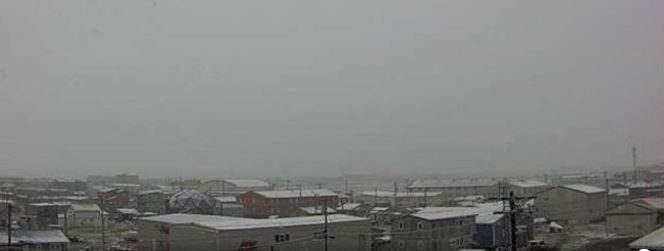
© NWS-FairbanksSnow falls in Utqiagvik - formerly Barrow - Alaska on July 7, 2018.
Alaska's showed off its weather contrasts the first week of July with record snow in the north and record heat in the south.
Wet snow mixed in with rain Saturday evening in Utqiagvik, formerly known as Barrow, as an Arctic Ocean storm pushed a cold front through, dropping 2 inches of wet snow.
This was the heaviest July snow in America's northernmost town since the Fourth of July 1963, according to Rick Thoman, climate science and services manager for the National Weather Service Alaska region.
A web cam Saturday evening showed a light coating of wet snow mainly on building roofs and vehicle tops.
Snow can fall in any month in Utqiagvik. Even during the warmest time of year, average low temperatures are still in the middle 30s, cold enough to allow snowflakes aloft to make it to the ground.
Before Saturday, there had been only five other July days with at least 2 inches of snowfall in Utqiagvik, according to NOAA's ACIS database with records dating to 1902.
Other than July 4, 1963, the four other days occurred either in the 1920s or 1930s, led by a 6-inch snowfall on July 29, 1922.
Baking in JulyTo say it's been a much different story in southern Alaska in July is an understatement.
Both Anchorage and Juneau recorded their hottest first week of July, according to Alaska-based climatologist Dr. Brian Brettschneider.
Most years, Anchorage fails to record a single 80-degree high. It did so twice last week, on July 3 and 6.
Southeast Alaska, known more for its rain, was basking and sweating in the sun.
Juneau soared to the 80s three straight days July 3-5 and tied a daily record high on July 4.
Perhaps more notable were the warm nights and mornings, relatively speaking.
On the same day it was snowing in Utqiagvik over 700 miles away, Anchorage came within 1 degree of tying its all-time record hottest low temperature July 7, dropping only to
62 degrees.
Juneau tied its all-time record hottest low temperatures July 6, dipping only to 60 degrees, a temperature closer to the average high in early July.
According to a new
report from NOAA, the first six months of 2018 have been more than 10 degrees above average for a large swath of Alaska's North Slope and western Alaska.

Reader Comments
to our Newsletter